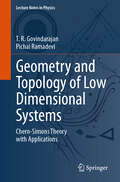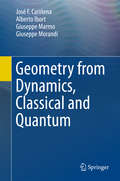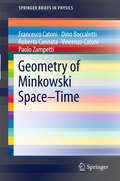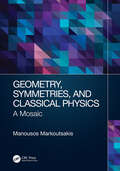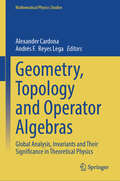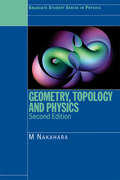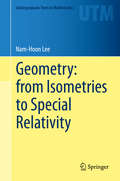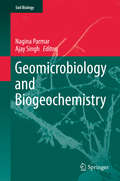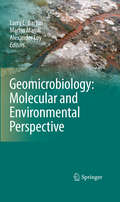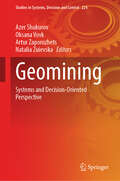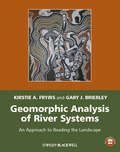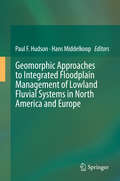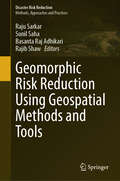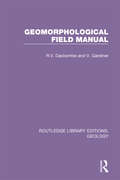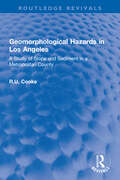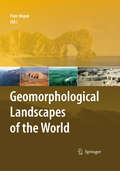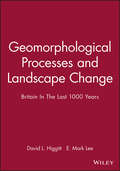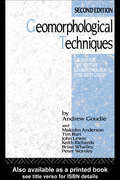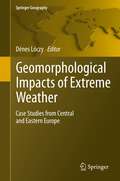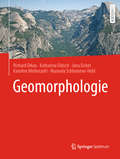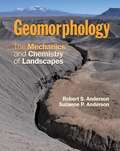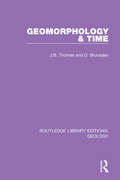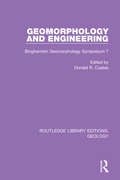- Table View
- List View
Geometry and Topology of Low Dimensional Systems: Chern-Simons Theory with Applications (Lecture Notes in Physics #1027)
by T. R. Govindarajan Pichai RamadeviThis book introduces the field of topology, a branch of mathematics that explores the properties of geometric space, with a focus on low-dimensional systems. The authors discuss applications in various areas of physics. The first chapters of the book cover the formal aspects of topology, including classes, homotopic groups, metric spaces, and Riemannian and pseudo-Riemannian geometry. These topics are essential for understanding the theoretical concepts and notations used in the next chapters of the book. The applications encompass defects in crystalline structures, space topology, spin statistics, Braid group, Chern-Simons field theory, and 3D gravity, among others. This self-contained book provides all the necessary additional material for both physics and mathematics students. The presentation is enriched with examples and exercises, making it accessible for readers to grasp the concepts with ease. The authors adopt a pedagogical approach, posing many unsolved questions in simple situations that can serve as challenging projects for students. Suitable for a one-semester postgraduate level course, this text is ideal for teaching purposes.
Geometry from Dynamics, Classical and Quantum
by Giuseppe Marmo José F. Cariñena Alberto Ibort Giuseppe MorandiThis book describes, by using elementary techniques, how some geometrical structures widely used today in many areas of physics, like symplectic, Poisson, Lagrangian, Hermitian, etc. , emerge from dynamics. It is assumed that what can be accessed in actual experiences when studying a given system is just its dynamical behavior that is described by using a family of variables ("observables" of the system). The book departs from the principle that ''dynamics is first'' and then tries to answer in what sense the sole dynamics determines the geometrical structures that have proved so useful to describe the dynamics in so many important instances. In this vein it is shown that most of the geometrical structures that are used in the standard presentations of classical dynamics (Jacobi, Poisson, symplectic, Hamiltonian, Lagrangian) are determined, though in general not uniquely, by the dynamics alone. The same program is accomplished for the geometrical structures relevant to describe quantum dynamics. Finally, it is shown that further properties that allow the explicit description of the dynamics of certain dynamical systems, like integrability and super integrability, are deeply related to the previous development and will be covered in the last part of the book. The mathematical framework used to present the previous program is kept to an elementary level throughout the text, indicating where more advanced notions will be needed to proceed further. A family of relevant examples is discussed at length and the necessary ideas from geometry are elaborated along the text. However no effort is made to present an ''all-inclusive'' introduction to differential geometry as many other books already exist on the market doing exactly that However, the development of the previous program, considered as the posing and solution of a generalized inverse problem for geometry, leads to new ways of thinking and relating some of the most conspicuous geometrical structures appearing in Mathematical and Theoretical Physics.
Geometry of Minkowski Space-Time
by Dino Boccaletti Paolo Zampetti Vincenzo Catoni Roberto Cannata Francesco CatoniThis book provides an original introduction to the geometry of Minkowski space-time. A hundred years after the space-time formulation of special relativity by Hermann Minkowski, it is shown that the kinematical consequences of special relativity are merely a manifestation of space-time geometry. The book is written with the intention of providing students (and teachers) of the first years of University courses with a tool which is easy to be applied and allows the solution of any problem of relativistic kinematics at the same time. The book treats in a rigorous way, but using a non-sophisticated mathematics, the Kinematics of Special Relativity. As an example, the famous "Twin Paradox" is completely solved for all kinds of motions. The novelty of the presentation in this book consists in the extensive use of hyperbolic numbers, the simplest extension of complex numbers, for a complete formalization of the kinematics in the Minkowski space-time. Moreover, from this formalization the understanding of gravity comes as a manifestation of curvature of space-time, suggesting new research fields.
Geometry, Symmetries, and Classical Physics: A Mosaic
by Manousos MarkoutsakisThis book provides advanced undergraduate physics and mathematics students with an accessible yet detailed understanding of the fundamentals of differential geometry and symmetries in classical physics. Readers, working through the book, will obtain a thorough understanding of symmetry principles and their application in mechanics, field theory, and general relativity, and in addition acquire the necessary calculational skills to tackle more sophisticated questions in theoretical physics. Most of the topics covered in this book have previously only been scattered across many different sources of literature, therefore this is the first book to coherently present this treatment of topics in one comprehensive volume. Key features: Contains a modern, streamlined presentation of classical topics, which are normally taught separately Includes several advanced topics, such as the Belinfante energy-momentum tensor, the Weyl-Schouten theorem, the derivation of Noether currents for diffeomorphisms, and the definition of conserved integrals in general relativity Focuses on the clear presentation of the mathematical notions and calculational technique
Geometry, Topology and Operator Algebras: Global Analysis, Invariants and Their Significance in Theoretical Physics (Mathematical Physics Studies)
by Alexander Cardona Andrés F. Reyes LegaThis book offers a comprehensive exploration of contemporary intersections between geometry, topology, and theoretical physics, emphasizing their mathematical foundations and applications. Originating from lectures presented by experts during two summer schools held in Villa de Leyva, Colombia, the book reflects the synergy between global analysis, operator algebras, and their role in modern physics. The chapters present state-of-the-art developments on a wide range of topics: the geometry and topology of foliations, affine manifolds, C*-algebras, and the pseudo-differential calculus of boundary value problems. These are enriched by applications to the theory of topological quantum matter. The book is suitable for graduate students and researchers, offering detailed introductions to advanced topics such as the longitudinal index theorem for foliations, the geometry of the Poincaré half-space in a C*-algebra, and mathematical frameworks for topological matter. With a balance of foundational material and novel insights, it serves as both a learning resource and a reference for advanced studies at the intersection of mathematics and physics.
Geometry, Topology and Physics
by Mikio NakaharaDifferential geometry and topology have become essential tools for many theoretical physicists. In particular, they are indispensable in theoretical studies of condensed matter physics, gravity, and particle physics. Geometry, Topology and Physics, Second Edition introduces the ideas and techniques of differential geometry and topology at a level suitable for postgraduate students and researchers in these fields.The second edition of this popular and established text incorporates a number of changes designed to meet the needs of the reader and reflect the development of the subject. The book features a considerably expanded first chapter, reviewing aspects of path integral quantization and gauge theories. Chapter 2 introduces the mathematical concepts of maps, vector spaces, and topology. The following chapters focus on more elaborate concepts in geometry and topology and discuss the application of these concepts to liquid crystals, superfluid helium, general relativity, and bosonic string theory. Later chapters unify geometry and topology, exploring fiber bundles, characteristic classes, and index theorems. New to this second edition is the proof of the index theorem in terms of supersymmetric quantum mechanics. The final two chapters are devoted to the most fascinating applications of geometry and topology in contemporary physics, namely the study of anomalies in gauge field theories and the analysis of Polakov's bosonic string theory from the geometrical point of view.Geometry, Topology and Physics, Second Edition is an ideal introduction to differential geometry and topology for postgraduate students and researchers in theoretical and mathematical physics.
Geometry: from Isometries to Special Relativity (Undergraduate Texts in Mathematics)
by Nam-Hoon LeeThis textbook offers a geometric perspective on special relativity, bridging Euclidean space, hyperbolic space, and Einstein’s spacetime in one accessible, self-contained volume. Using tools tailored to undergraduates, the author explores Euclidean and non-Euclidean geometries, gradually building from intuitive to abstract spaces. By the end, readers will have encountered a range of topics, from isometries to the Lorentz–Minkowski plane, building an understanding of how geometry can be used to model special relativity. Beginning with intuitive spaces, such as the Euclidean plane and the sphere, a structure theorem for isometries is introduced that serves as a foundation for increasingly sophisticated topics, such as the hyperbolic plane and the Lorentz–Minkowski plane. By gradually introducing tools throughout, the author offers readers an accessible pathway to visualizing increasingly abstract geometric concepts. Numerous exercises are also included with selected solutions provided. Geometry: from Isometries to Special Relativity offers a unique approach to non-Euclidean geometries, culminating in a mathematical model for special relativity. The focus on isometries offers undergraduates an accessible progression from the intuitive to abstract; instructors will appreciate the complete instructor solutions manual available online. A background in elementary calculus is assumed.
Geomicrobiology and Biogeochemistry
by Ajay Singh Nagina ParmarOver the past 4 billion years, microorganisms have contributed to shaping the earth and making it more habitable for higher forms of life. They are remarkable in their metabolic diversity and their ability to harvest energy from oxidation and reduction reactions. Research on these microbiological processes has led to the newly evolving fields of geomicrobiology and biogeochemistry, linking the geosphere and the biosphere. This volume of the Soil Biology series provides an overview of the biogeochemical processes and the microorganisms involved, with an emphasis on the industrial applications. Topics treated include aspects such as bioremediation of contaminated environments, biomining, biotechnological applications of extremophiles, subsurface petroleum microbiology, enhanced oil recovery using microbes and their products, metal extraction from soil, soil elemental cycling and plant nutrition.
Geomicrobiology: Molecular and Environmental Perspective
by Larry L. Barton Alexander Loy Martin MandlThis book is an interdisciplinary review of recent developments in topics including origin of life, microbial-mineral interactions, and microbial processes functioning in marine and terrestrial environments. A major component of this book addresses molecular techniques to evaluate microbial evolution and assess relationships of microbes in complex, natural communities. The function of microbial community members and their possible geological impact are evaluated from a perspective of (meta)genomics, (meta)proteomics, and isotope labeling. As well as summarizing current knowledge in various areas, it also reveals unresolved questions that require future investigations. These chapters enhance our fundamental knowledge of geomicrobiology that contributes to the exploitation of microbial functions in mineral and environmental biotechnology applications. Authors have provided skillful reviews and outlined unique perspectives on environmental microorganisms and their related processes.
Geomicrobiology: Natural and Anthropogenic Settings
by Larry L. Barton Lucian C. StaicuThis volume brings together leading international experts to offer a unique and timely perspective on geomicrobiology through their latest research and findings. Chapters address interactions of marine and freshwater microorganisms contributing to geochemical cycles, including biochemical mechanisms for mineralization and transformation of solid minerals and dissolved metals. In addition, the resilience and physiological elasticity of specific bacteria in extreme environments is discussed, such as mechanisms of metal homeostasis and electrochemistry involving extracellular electron flow. Further coverage includes resource recovery (metals, minerals) using microbial-driven processes and technologies, with the aim to contribute to a better understanding of microbial potential within the framework of circular economy. This book is designed for professionals and students, including environmental engineers, microbiologists, and individuals studying the interaction of bacteria with metals and minerals in the environment. It is also a resource for students in academic programs or short courses focused on bacterial diversity in the environment, systems of bacterial energetics, resource recovery, and bacterial activities in extreme or nutrient-stressed environments. .
Geomining: Systems and Decision-Oriented Perspective (Studies in Systems, Decision and Control #224)
by Artur Zaporozhets Azer Shukurov Oksana Vovk Natalia ZuievskaThis book represents a comprehensive exploration of the intricate intersection between geology and mining through the lens of system-oriented perspectives. Geomining stands at the forefront of modern resource extraction, blending the principles of geology, engineering, transport, and environmental science to optimize the extraction of minerals and other valuable resources from the Earth's crust. It is a dynamic field that continually evolves in response to technological advancements, environmental concerns, and economic realities. In this book, we aim to capture the essence of geomining as a holistic system, emphasizing the interconnectedness of its various components and the importance of integrated approaches to resource management. The geomining is a complex of heavy industry sectors that includes the exploration of mineral deposits, the extraction of minerals from the Earth's subsurface, and the enrichment of valuable minerals. Among the main groups of the geomining industry, the following are distinguished—fuel extraction (coal, oil, shale, peat, natural gas extraction); ore mining (iron ore, manganese ore, extraction of non-ferrous ores, precious and rare metals, etc.); mining and chemical industry (extraction of potassium salts, rock salt, apatites, nephelines, bauxites, sulfur, phosphorites, etc.); extraction of mineral raw materials for the construction industry; extraction of mineral raw materials for refractory and ceramic industries; hydromeliorative activities. The concept of a system-oriented view on geomining recognizes that mining activities do not occur in isolation but are part of larger, interconnected systems that encompass geological, environmental, social, and economic dimensions. By adopting a systems perspective, we can better understand the complexities inherent in resource extraction and develop more sustainable and efficient mining practices. This book is divided into 3 parts, each focusing on different aspects of geomining from a systems perspective.
Geomorphic Analysis of River Systems
by Gary J. Brierley Kirstie A. FryirsFilling a niche in the geomorphology teaching market, this introductory book is built around a 12 week course in fluvial geomorphology.'Reading the landscape' entails making sense of what a riverscape looks like, how it works, how it has evolved over time, and how alterations to one part of a catchment may have secondary consequences elsewhere, over different timeframes. These place-based field analyses are framed within their topographic, climatic and environmental context. Issues and principles presented in the first part of this book provide foundational understandings that underpin the approach to reading the landscape that is presented in the second half of the book. In reading the landscape, detective-style investigations and interpretations are tied to theoretical and conceptual principles to generate catchment-specific analyses of river character, behaviour and evolution, including responses to human disturbance. This book has been constructed as an introductory text on river landscapes, providing a bridge and/or companion to quantitatively-framed or modelled approaches to landscape analysis that are addressed elsewhere. Key principles outlined in the book emphasise the importance of complexity, contingency and emergence in interpreting the character, behaviour and evolution of any given system.The target audience is second and third year undergraduate students in geomorphology, hydrology, earth science and environmental science, as well as river practitioners who use geomorphic understandings to guide scientific and/or management applications.The primary focus of Kirstie and Gary's research and teaching entails the use of geomorphic principles as a tool with which to develop coherent scientific understandings of river systems, and the application of these understandings in management practice. Kirstie and Gary are co-developers of the River Styles® Framework and Short Course that is widely used in river management, decision-making and training.Additional resources for this book can be found at: www.wiley.com/go/fryirs/riversystems.
Geomorphic Approaches to Integrated Floodplain Management of Lowland Fluvial Systems in North America and Europe
by Paul F. Hudson Hans MiddelkoopThis volume provides a comprehensive perspective on geomorphic approaches to management of lowland alluvial rivers in North America and Europe. Many lowland rivers have been heavily managed for flood control and navigation for decades or centuries, resulting in engineered channels and embanked floodplains with substantially altered sediment loads and geomorphic processes. Over the past decade, floodplain management of many lowland rivers has taken on new importance because of concerns about the potential for global environmental change to alter floodplain processes, necessitating revised management strategies that minimize flood risk while enhancing environmental attributes of floodplains influenced by local embankments and upstream dams. Recognition of the failure of old perspectives on river management and the need to enhance environmental sustainability has stimulated a new approach to river management. The manner that river restoration and integrated management are implemented, however, requires a case study approach that takes into account the impact of historic human impacts to the system, especially engineering. The river basins examined in this volume provide a representative coverage of the drainage of North America and Europe, taking into account a range of climatic and physiographic provinces. They include the 1) Sacramento (California, USA), 2) San Joaquin (California), 3) Missouri (Missouri, USA), 4) Red (Manitoba, Canada and Minnesota, USA), 5) Mississippi (Louisiana, USA), 6) Kissimmee (Florida, USA), 7) Ebro (Spain), 8) Rhone (France), 9) Rhine (Netherlands), 10) Danube (Romania), and 11) Volga (Russian Federation) Rivers. The case studies covered in these chapters span a range of fluvial modes of adjustment, including sediment, channel, hydrologic regime, floodplains, as well as ecosystem and environmental associations.
Geomorphic Risk Reduction Using Geospatial Methods and Tools (Disaster Risk Reduction)
by Rajib Shaw Basanta Raj Adhikari Raju Sarkar Sunil SahaThis book explores the use of advanced geospatial techniques in geomorphic hazards modelling and risk reduction. It also compares the accuracy of traditional statistical methods and advanced machine learning methods and addresses the different ways to reduce the impact of geomorphic hazards.In recent years with the development of human infrastructures, geomorphic hazards are gradually increasing, which include landslides, flood and soil erosion, among others. They cause huge loss of human property and lives. Especially in mountainous, coastal, arid and semi-arid regions, these natural hazards are the main barriers for economic development. Furthermore, human pressure and specific human actions such as deforestation, inappropriate land use and farming have increased the danger of natural disasters and degraded the natural environment, making it more difficult for environmental planners and policymakers to develop appropriate long-term sustainability plans. The most challenging task is to develop a sophisticated approach for continuous inspection and resolution of environmental problems for researchers and scientists. However, in the past several decades, geospatial technology has undergone dramatic advances, opening up new opportunities for handling environmental challenges in a more comprehensive manner.With the help of geographic information system (GIS) tools, high and moderate resolution remote sensing information, such as visible imaging, synthetic aperture radar, global navigation satellite systems, light detection and ranging, Quickbird, Worldview 3, LiDAR, SPOT 5, Google Earth Engine and others deliver state-of-the-art investigations in the identification of multiple natural hazards. For a thorough examination, advanced computer approaches focusing on cutting-edge data processing, machine learning and deep learning may be employed. To detect and manage various geomorphic hazards and their impact, several models with a specific emphasis on natural resources and the environment may be created.
Geomorphological Field Manual (Routledge Library Editions: Geology #12)
by R. Dackombe V. GardinerThis book, first published in 1983, incorporates a wealth of reference material – keys, nomograms, tables, charts – likely to be needed in the field for actual fieldwork. The widest possible coverage of material is provided in anticipation of problems that individual specialists will encounter on the periphery of their main areas of interest.
Geomorphological Hazards and Disaster Prevention
by Andrew S. Goudie Irasema Alcántara-AyalaHuman activities have had a huge impact on the environment and landscape, through industrialisation and land-use change, leading to climate change, deforestation, desertification, land degradation, and air and water pollution. These impacts are strongly linked to the occurrence of geomorphological hazards, such as floods, landslides, snow avalanches, soil erosion, and others. Geomorphological work includes not only the understanding but the mapping and modelling of Earth's surface processes, many of which directly affect human societies. In addition, geomorphologists are becoming increasingly involved with the dimensions of societal problem solving, through vulnerability analysis, hazard and risk assessment and management. The work of geomorphologists is therefore of prime importance for disaster prevention. An international team of geomorphologists have contributed their expertise to this volume, making this a scientifically rigorous work for a wide audience of geomorphologists and other Earth scientists, including those involved in environmental science, hazard and risk assessment, management and policy.
Geomorphological Hazards in Los Angeles: A Study of Slope and Sediment in a Metropolitan County (Routledge Revivals)
by R.U. CookeThis book, first published in 1984, deals authoritatively with the nature and management of slope failures and sediment movement and their impact on the hazardous landscape of Los Angeles county. Bringing together for the first time a wide range of information derived from field observations, interviews, manuscript records, local agency reports and published sources, the book presents an analysis of the ways in which a rapidly developing metropolis has come to terms with complex geomorphological hazards. In particular, the events accompanying the major storms of 1914, 1934, 1969 and 1978 are reconstructed in detail.
Geomorphological Landscapes of the World
by Piotr MigonPhysical landscapes are one of the most fascinating facets of our Planet, which tell stories about the evolution of the surface of the Earth. This book provides up-to-date information about the geomorphology of the selected 'classic' sites from around the world and shows the variety of geomorphological landscapes as moulded by different sets of processes acting over different timescales, from millions of years to days. The volume is written by nearly fifty geomorphologists from more than twenty countries who for many years have researched some of the unique sceneries on the planet. The thirty six chapters present each continent of the world. They describe landscapes of different origin, so that the reader can learn about the complexity of processes behind the sceneries. This is a useful reference book, linking geomorphology with global initiatives focused on nature conservation.
Geomorphological Processes and Landscape Change: Britain In The Last 1000 Years (RGS-IBG Book Series #69)
by David L. Higgitt E. Mark LeeThe expert contributors to this cutting edge volume provide an overview of geomorphological process activity and landscape change in Britain over the past 1000 years. The range of the book is unusually broad, encompassing hillslope, valley floor and floodplain, fluvial, estuarine and coastal processes. Provides an overview of geomorphological process activity and landscape change in Britain over the past 1000 years. The range of the book is unusually broad, encompassing hillslope, valley floor and floodplain, fluvial, estuarine and coastal processes. Considers the relevance of technological and conceptual approaches to understanding landscape dynamics. Examines key process environments highlighting significant trends and the influence of human activity, and incorporating examples and modelling. Encourages geographers to look forward to the challenges that geomorphology faces in the new millennium. Find out more information about the RGS-IBG journals by following the links below: AREA: http://www.blackwellpublishing.com/journal.asp?ref=0004-0894 The Geographical Journal: http://www.blackwellpublishing.com/journal.asp?ref=0016-7398 Transactions of the Insititute of British Geographers: http://www.blackwellpublishing.com/journal.asp?ref=0020-2754
Geomorphological Techniques
by Andrew GoudieThe specialist contributors to Geomorphological Techniques have thoroughly augmented and updated their original, authoritative coverage with critical evaluations of major recent developments in this field. A new chapter on neotectonics reflects the impact of developments in tectonic theory, and heavily revised sections deal with advances in remote sensing, image analysis, radiometric dating, geomorphometry, data loggers, radioactive tracers, and the determination of pore water pressure and the rates of denudation.
Geomorphological impacts of extreme weather
by Denes LoczyThis book presents new research on the geomorphological impacts of extreme precipitation events. It focuses on the extreme summer floods, which affected Central and Eastern Europe in 2010. Case studies on their consequences, including inundations, urban flooding, soil erosion, river bank retreat, alluvial fan accumulation, evolution of karst depressions, debris flows, landslides and soil saturation are presented for Poland, the Czech Republic, Ukraine, Slovakia, Hungary, Romania, Slovenia, Croatia, Serbia, Bulgaria and Macedonia. This key applied geomorphology book is crucial for anyone interested in these processes and their consequences and also for decision makers who face these catastrophes.
Geomorphologie: Proceedings Of The Walter F. Wood Memorial Symposium, 3rd International Conference On Geomorphology, Mcmaster University, Hamilton, Ontario, Canada, August 23-28, 1993 (Zeitschrift Für Geomorphologie Ser. #Vol. 101)
by Richard Dikau Katharina Eibisch Jana Eichel Karoline Meßenzehl Manuela Schlummer-HeldDieses Lehrbuch vermittelt Ihnen Einblicke, wie Gletscher, Bergstürze, Flüsse oder Vulkanausbrüche die Reliefformen unserer Erde erschaffen, verändern und zerstören. Sie erfahren, welch außerordentliche Vielzahl der von Menschen unberührten natürlichen Prozesse an der Formung der Erdoberfläche mitwirken. Unser Buch hilft Ihnen, diese Vielfalt zu ordnen und in eine übersichtliche Systematik zu bringen. Die einzelnen Prozesse und Formen werden in Grundzügen beschrieben und mit zahlreichen fotographischen Beispielen dokumentiert. Daneben bieten wir Ihnen allgemeine Grundlagen für das Verständnis der reliefformenden Prozesse, wie die Art und Weise der Wissensgewinnung oder die Entwicklungsgeschichte der Reliefformen. Um Ihnen einen Einblick in die Praxis des wissenschaftlichen Arbeitens zu geben, haben wir zwei Fallstudien in das Lehrbuch aufgenommen. Sie zeigen exemplarisch, welche Konsequenzen die menschlichen Eingriffe in die Reliefformen bewirken können und welche Folgen in Zukunft möglich sind. Wir erhoffen uns, dass dieses Lehrbuch Wissen vermittelt, Fragen beantwortet, den Blick auf unsere Erdoberfläche schärft und Leidenschaften für die natürlichen Reliefformen weckt. Als Bestandteil des Naturschönen bilden sie Erscheinungen, die es zu erhalten und zu schützen gilt.
Geomorphology
by Robert S. Anderson Suzanne P. AndersonThis textbook provides a modern, quantitative and process-oriented approach to equip students with the tools to understand geomorphology. Insight into the interpretation of landscapes is developed from basic principles and simple models, and by stepping through the equations that capture the essence of the mechanics and chemistry of landscapes. Boxed worked examples and real-world applications bring the subject to life for students, allowing them to apply the theory to their own experience. The book covers cutting edge topics, including the revolutionary cosmogenic nuclide dating methods and modeling, highlights links to other Earth sciences through up-to-date summaries of current research, and illustrates the importance of geomorphology in understanding environmental changes. Setting up problems as a conservation of mass, ice, soil, or heat, this book arms students with tools to fully explore processes, understand landscapes, and to participate in this rapidly evolving field.
Geomorphology & Time (Routledge Library Editions: Geology #15)
by J.B. Thornes D. BrunsdenTime is a central feature of geomorphological research, and is used in this book (first published in 1977) to provide a conceptual framework within which to consider and compare old and new approaches to the field of geomorphology. The emphasis is on providing not merely a manual of current research but an introduction to isolate ideas and concepts, stimulate critical discussion and examine some of the problems that are involved in dealing with data.
Geomorphology and Engineering: Binghamton Geomorphology Symposium 7 (Routledge Library Editions: Geology #14)
by Donald R. CoatesWhether the project is river engineering, soil mapping for landuse planning, or control of landslides, this volume, first published in 1976, illustrates that the professional partnership between geomorphology and engineering can significantly minimize environmental damage. The papers here were presented at the 7th Binghamton Geomorphology Symposium, and using the broad viewpoint of the planner, much new ground is covered: landfill design, prediction of geomorphic processes and their effects, and minimization of streamflow distortion.
